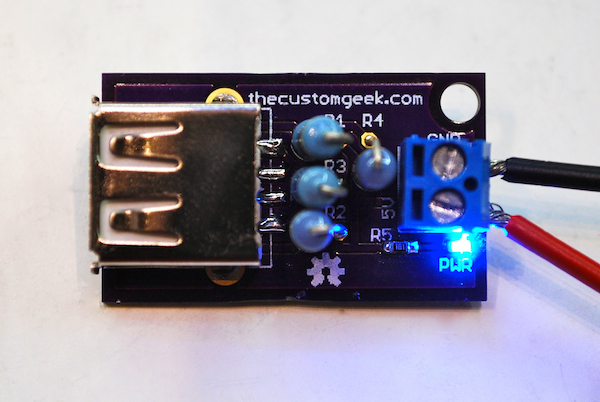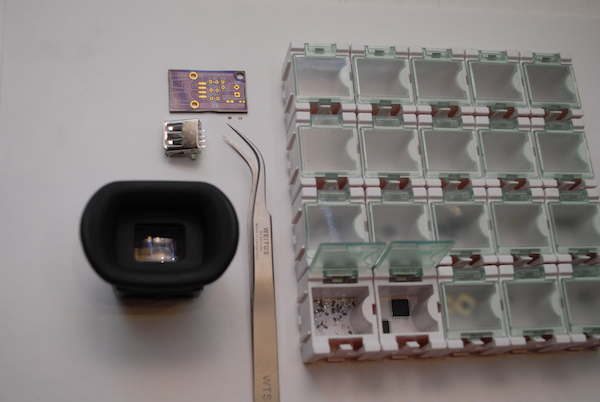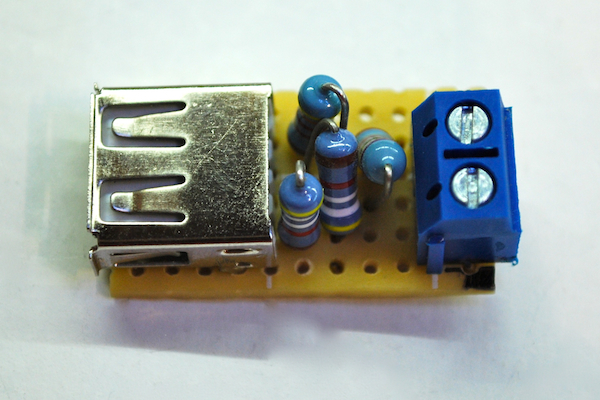I had a post a while back on charging an iDevice (iPhone, iPad, iPod) and talked about and showed a schematic for the charging circuit. This design is based (and the schematic is almost exact!) off of Ladyada’s Reverse engineering Apple’s secret charging methods. (video link, it’s good, you should watch it!) I give her full credit for the circuit. Now, the boards I whipped up in a few hours, and had it made from DorkbotPDX service. I sent off the files and 2 weeks later, I got three perfect purple PCB’s. The boards cost a total of $4.69. Shipped. You can’t beat that with a stick! Now, I have a nice little iDevice charger that accepts standard 5 volt power from any standard power supply. Although I do tend to favor 5V 2A supplies from Adafruit.
I used the same circuit I had in the old post, just added an LED and resistor for a power indicator. I had an old cell phone from 2006, and saved the keypad because it lit up blue. (Can you blame me?) Now, 6 years later those tiny 603 blue LED’s come in handy. I got the 603 resistor from an old PC motherboard. Motherboards have a slew of SMD things on them. So I fired up the hot air rework station, grabbed my tweezers, and voila! SMD parts! (I did order some reels of 603 resistors and LED for use in future kits, sorry peeps, no old motherboard parts for you!) I use a good pair of tweezers, and a viewfinder from an old camcorder to inspect my work. “But Jeremy? Where do you keep all of those SMD parts?” you ask? Good question, I use these awesome Modular Snap SMD component storage boxes from Adafruit. They have spring loaded tops, and they are modular, you can form them in any configuration you want! How cool is that?!
I’m thinking about getting some more made and selling them as kits, partially assembled (the SMD 603 LED and resistor) or fully assembled. Let me know if you’re interested. Not a for sure thing, but I’ll watch the feedback.

Below is a picture of the 2 other boards I did not populate yet, along with the prototype I made the other day. Happy iCharging! Eagle files are on Github.





I’d be interested in getting a blank PCB if you do plan on distributing them.
Is there a reason why you didn’t use surface mount resistors throughout the entire project? It’s not like you could have made the board much smaller than it is now, but it’d make production easier if you wanted to do bigger production runs.
Hi Harry, thanks for the commit. I kind of made this on a whim, quick and dirty so to speak, without thoughts of mass production. Also the fact that I had the resistor values (43.2KΩ, 49.9KΩ, and 75KΩ) in through hole parts(didn’t have the SMD resistors in those values), so I just spent the $5 and got a set of those ‘hybrid’ boards made.
I did however revise the board with all SMD, barrel jack, and LDO regulator. I ordered it earlier this week (along with all the goodies that go on it), and I’ll do a post on it when I get it in. This will be a more “universal” board with the regulator on it as well as the barrel jack for power. I can’t wait to test it out. 🙂
Ah, okay. I actually just submitted a pull request on github that changed all of the resistors to 0805 SMD and tightened up the board a bit, but otherwise left the same style. Also added a BOM/quote from digikey.
What LDO did you use? Be careful, I’ve blown a few LDOs before thinking they had the same input voltage range as a 7805… Input voltage is a good thing to make a note of on the PCB, in particular. But I’m sure you’ve got it under control.
Thanks for the work! The LDO I picked is a LD29150DT50R from STMicroelectronics. It has an input voltage up to 30V and outputs up to 1.5A (for the iPad). I have charged iPads with this circuit, and it draws just over 1A with the resistor configuration.
Don’t mind the shout out about the LDO, to put it kindly, in my days I have earned the Magic Blue Smoke Monster badge.. 🙂
Pingback: Dorkbot PDX PCB’s | The Custom Geek
Pingback: SMD iPad Charger | The Custom Geek
Im looking into constructing something simular to this (but with a few more bits)
anyway I was wondering if you are able to charge the iPad at 2A with those resistor values?
Basically I would like to find the magic values that causes devices to charge at 2A and 1A as I have budget of 5A over 4 ports.
Hi Hovo, I was able to charge an iPad with this, it pulled about 1.1A with this resistor setup. You don’t have to worry about the resistor wattage as they just provide the signal to tell the device it’s ok to charge. I actually did a SMD version of this here: http://www.thecustomgeek.com/2012/05/08/smd-ipad-charger/ I used 1/16 watt resistors, and I use it all the time.
Also might want to check out this post: http://www.thecustomgeek.com/2011/08/03/charging-an-ipad-iphone-or-ipod/
Happy hacking!
Sorry should have explained myself better,
Im looking for the resistors or voltage required on the data pins to tell the iPad to charge at 2A or 1A.
The idea is I can dedicate one port for 2A charging and the other at 1A so I dont overload the power supply.
If you dont have this information I might do some hacking and hope I dont break my iPad.
Will post the results as I can’t find them anywhere on the net.
Cheers
Battery USB Port Current D- D+
V11 USB Battery 900mA 2.75V 2.0V
V39 “low-power” port 600mA 2.0V 2.0V
V39 “high-power” port 2,000mA 2.0V 2.75V
V60 1,000mA 2.75V 2.0V
Source:
http://voltaicsystems.com/blog/choosing-usb-pin-voltages-for-iphones-and-ipads/
Thanks Scott..